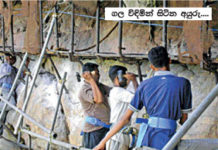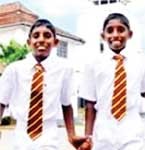By Rajasinghe
When the Sri Lankan cricket team left for the UAE to compete in the T20 Asia Cup matches, not many gave them a chance of even reaching the semi-finals.
We had to compete in qualifiers with Afghanistan and Bangladesh even before the competition for the Asia Cup began. Ranged against us were some of the world’s best teams in white ball cricket, namely, India, Pakistan, Bangladesh, and Afghanistan. We had a sad record of losing to all of them.
All the predictions of a dismal performance and a quick return to the island for our young and untested team seemed to come true in the first match against Afghanistan. The Afghan fast bowlers terrorised our batsmen and we suffered a humiliating defeat.
The world’s cricket commentators said ‘we told you so’. In Sri Lanka, the unforgiving social media tore the players apart. Some of the venom was directed at skipper Dasun Shanaka, saying that he had no leadership qualities and he let his players wander around without discipline. His own qualifications as an all-rounder were under scrutiny. Then a metamorphosis took place.
Taking the cricketing world by storm
It may have been the magnitude of the humiliating defeat. Or it may have been the fear of the reaction at home if they returned without even entering the competition. In any event, a ‘band of brothers,’ in the words of Maheesh Theekshana, emerged and under Dasun Shanaka’s superb leadership they took the cricketing world by storm.
Sri Lanka won every subsequent match and emerged winner of the trophy after a phenomenal performance which will be remembered by sports lovers for a long time to come.
But first, they had to enter the competition by winning a qualifying match against Bangladesh. If they lost they would have got a one-way ticket home. Bangladesh had emerged over time as our cricketing enemy. While India and Pakistan were our rivals, they were considered far superior to us. Consequently, Bangladesh and Sri Lanka were pitted against each other and honours were shared equally between the two teams in recent times.
But the rivalry assumed a certain venom when the victorious Bengalis led by wicketkeeper and prolific run-getter Mushfiqur Rahim led a snake dance to humiliate the Sri Lankans in their home grounds at Pallekele.
In this match we opted to field first and then launch an aggressive attack to reach the winning runs. Another feature was that at least one player came good in each match and took the game away from the other side. The most consistent was Pathum Nissanka – a great find who has the technical skills and correct temperament to anchor the opening pair and score freely during the first few overs.
Twenty-over winning strategies
Twenty-over white ball cricket demands its own winning strategies. Sri Lanka dominated a certain period of the game because, led by Coach Whatmore, we innovated an attacking approach from the first over when the field was restricted.
Sanath Jayasuriya and Romesh Kaluwitharana exploded as batsmen in the first five overs, giving a headstart in our scorecard, demoralising the opposition, and posting a score which could not be reached by the more conventional ‘thattu cricket’ in setting up a platform for reaching the high scores our team ended up with.
It was skillful and entertaining cricket which commentators like Tony Grieg introduced to the audiences, which were enthralled by our brand of cricket. Many compared our cricketers to the West Indian giants who mixed cricket with entertainment.
After dispatching the Bangladeshis home, we entered the finals and took on the Afghans in a return encounter.
This was the beginning of the turnaround. After this, several of our batsmen who had bad spells came back strongly, particularly Kusal Mendis, Danushka Gunathilaka, Dasun Shanaka, Wanindu Hasaranga, and Bhanuka Rajapaksa. All this while Pathum Nissanka held up his end, enabling our team to win the run chase.
Always someone to the rescue
An interesting aspect was that when some batsmen in the top order failed, there was always someone who came to the rescue by holding up a partnership and keeping the scoreboard ticking. The rescuer could be any one of the batters listed above or even Dhananjaya de Silva in the last match who ensured that there was no debacle to bar the search for the high score of the opposing team that we were chasing.
The classic rescue act was that of Bhanuka, who, with his unbeaten 71 in the last match, took the game away from Pakistan and brought us the Asia Cup. While the other teams depended on one or two batters to amass their runs as in the case of Virat Kohli, Rohit Sharma, Rizwan, or Mushfiqur Rahim, our contingent of batsmen was good enough for 30 or 40 runs each at crunch time. Our opponents could not run through the side as it normally happens.
In addition, whenever we desperately wanted it, our tail also wagged – especially in the case of fast bowler Asitha Fernando, whose big hitting brought us victory in the last overs of a match.
World-class bowling
At the beginning our bowling was the butt of snide humour. The Pakistan coach was reported to have said that we had no world-class bowlers. Our strategy of fielding first and chasing the runs of our opponents is predicated on the ability of our bowlers to keep their score low. Many felt that 180 runs, which we chased in this tournament, was a good competitive score. But it was our skillful bowlers who kept it at that range in the face of world-class top order batsmen.
Our debutant quicks were effective, as was Theekshana and the other spinners. But the match winner was Hasaranga. In him we have a world-class spin bowler who can deliver the goods at the correct time, as was the case in the finals against Pakistan.
All this shows the need for our players to be allowed to compete in international series, including the league games. India, for example, has honed the skills of its players through the IPLs. The more our young team plays hard competitive cricket, the more they will be able to retain our hardwon eminence in this version of cricket.
What a skipper!
Finally, one must commend the cool, unhurried, and friendly approach of skipper Dasun Shanaka. He held the team together and led from the front. He was able to perform well with both bat and ball at crucial times. His fielding was exemplary. It is only this type of friendly leadership that can hold a group of youngsters from disparate backgrounds together and weld them into a fighting force.
There was a time when our cricket was confined to a few metropolitan schools. Cricketers came from fairly affluent backgrounds, but no more. Top-class players like Dasun are coming from suburban schools and are absorbed into club cricket. Their natural abilities are honed by regular practice and competitions. They are match winners who have come up the hard way and know how to mingle with players of different backgrounds. Dasun’s natural modesty is an appealing aspect of his character as is his steely determination.
A wonderful cameo comes to mind. At the end of the Indian series, when coach Rahul Dravid walked across to speak to Shanaka, the Sri Lankan captain courteously and touchingly took off his cap to honour the great Indian player. It did not go unnoticed. The next day when he came to speak to Shanaka, Dravid took off his cap as a salute to a young gentleman player who was leading Sri Lanka. That is ‘cricket, lovely cricket,’ as the West Indians used to say.
TheMorning





















